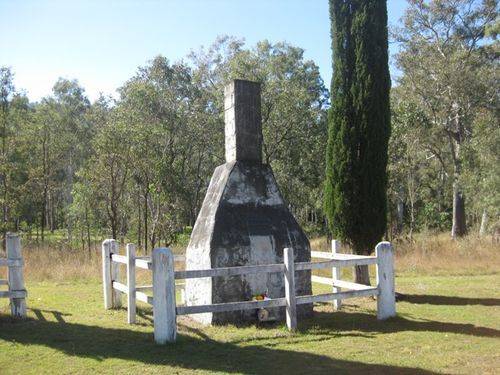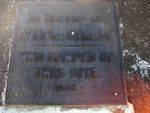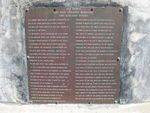
Home » Themes » Conflict » World War Two
Sheep Station Creek Memorial ChimneyPrint Page 
The chimney commemorates the 2nd / 10th Battalion, 18th Brigade AIF who camped on the site in 1942.
The 2nd / 10th Battalion, or Adelaide Rifles, trained here before serving in New Guinea in World War Two. They had already been in action in Tobruk, Palestine and Syria. Of the 760 members, 237 were killed and 319 wounded. The memorial chimney was part of a building constructed and used by these men while in the district. An engraved plaque gives the history of the group, with memorial pine trees honouring Hector Ellis and Jim Webster. The site is maintained by neighbour, Mrs Ruth Pratten, and the Kilcoy RSL.
Ex-servicemen will attend an unveiling of a monument to themselves which they built at Kilcoy nine years ago. The monument — a chimney from a former Army recreation hut — will be unveiled on Saturday. The chimney will commemorate the 18th Brigade 2nd A.I.F., which included the 2/9th, 2/10th, and 2/12th battalions. It was part of a recreation hut erected in 1942 by men of the 2/10th Battalion camped at Sheep Station Creek, about four miles from Kilcoy.
Courier-Mail (Brisbane), 31 October 1951.
Location
| Address: | Kilcoy-Murgon Road, Sheep Station Creek, 8 kms N of Kilcoy, Kilcoy, 4515 |
|---|---|
| State: | QLD |
| Area: | AUS |
| GPS Coordinates: | Lat: -26.854742 Long: 152.510582 Note: GPS Coordinates are approximate. |
Details
| Monument Type: | Structure |
|---|---|
| Monument Theme: | Conflict |
| Sub-Theme: | WW2 |
| Actual Event Start Date: | 03-September-1939 |
| Actual Event End Date: | 15-August-1945 |
Dedication
| Actual Monument Dedication Date: | Saturday 3rd November, 1951 |
|---|
In memory of 2 / 10 /Btn. 18 BDE.,A·I·F. who camped on this site.
• 1942 •
Pro Patria
2 / 10 Aust. Infantry Battalion
(The Adelaide Rifles)
This chimney was part of a building constructed by the men of the 2/10th battalion A.I.F. who camped in this area for three months in 1942 and trained in the hills to the north. The Battalion, a South Australian Unit also known as the Adelaide Rifles, has a history dating back to 1860 and a proud record of service in the South African War , the Great War of 1914/19 and World War 11 1939/45. The Regimental Colours which are laid up in Saint Peters Cathedral Adelaide are emblazoned with many battle honours including the landing at ANZAC, where the 10th was the spearhead of the landing force. The Adelaide Rifles have always been regarded as the City of Adelaide’s own infantry regiment and in recognition of this, a flag bearing the Corporation Arms is dipped in salute whenever this unit passes the Adelaide Town Hall. The unit was granted the freedom of the city in 1960 to mark the 100th anniversary of its foundation.
The 2/10th battalion was formed in November 1939, sailed from Sydney of 5th May 1940 and served in England during the Battle of Britain. Moving back to Egypt in early 1941 as part of the 18th Brigade in support of the 9th Division, the battalion played a prominent role in the defence of Tobruk during the siege and after further service in Palestine and Syria returned to Australia in March 1942 camping here from early May to 6th August when they moved to Papua New Guinea. Following the Battle of Milne Bay which was the first defeat of Japanese land forces in the war the Battalion went on to further victories at Buna and Sanananda, won at the cost of many casualties in conditions of extreme hardship of the 760 young men who lived here briefly many were never to see their homeland again. The remnants of the Battalion returned to Australia in March 1943 after losing 237 killed and 319 wounded. On regrouping the Battalion absorbed the 11th Motor Regiment, mostly N.S.W. and Queensland men who proved their worth as fighting troops by carrying on the best tradition of the tenth in operations in the Ramu Valley during 1944 and a brilliant amphibious operation at Balikapan in Borneo in July 1945. The final action of the unit which was disbanded on 29th January 1946 after more than six years service during which more than 3,400 men passed through the ranks.
This memorial was established by Mrs. Ruth Pratten and family, owners of the adjacent property and residents of Kilcoy as a mark of esteem in which the unit was held by them and is maintained by the Kilcoy R.S.L.







